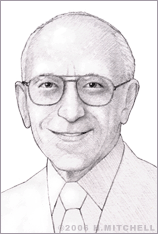Ralph Baer
The smashing success of home video games, one of the world’s fastest growing and most popular forms of entertainment, was made possible with the advent of a number of technological developments, such as TV sets, computer technology, and graphic design software. It took some groundbreaking creativity, unusual innovation, and exceptional vision for this multi-billion dollar business to come into existence. Ralph Baer, often called the “father of home video games,” clearly demonstrated each of these qualities when he developed the first home video game console in 1972.
Born in Germany on March 8, 1922, Baer emigrated to the United States with his family in 1938 and attended the National Radio Institute, from where he graduated in 1940 as a radio service technician. He operated three radio service stores in New York City from 1940 to 1943 before being drafted into the U.S. Army to serve in WWII. He continued his education in 1946 at the American Institute of Technology in Chicago. He graduated with a BS in Television Engineering in 1949.
Baer worked on electromechanical equipment including military systems while employed by Wappler, Inc., then Loral Electronics, and next Transitron, Inc., where he became VP of Engineering and moved with the firm from New York to Manchester, N.H., in 1955. In 1956 he joined Sanders Associates (now part of BEA Systems) in Nashua, N.H., where he held posts such as Chief Engineer for Equipment Design, Manager of Sanders’ Flexprint Division, Chief Engineer of the Electro-Optics division, and Engineering Fellow until his official retirement in 1987.
In the early 1950s, television sets were quickly gaining popularity. As Baer worked on technology for these devices, he began to dream of opportunities in this budding marketplace. He thought it would be fun to add some kind of interactive, game-playing element to TV sets and mentioned it to his superiors at Loral in 1951, but few showed any interest.
Fifteen years later, though, Baer found himself thinking more seriously about the concept. He began drawing up plans for a chase game that would be playable on a TV screen. He demonstrated a working prototype to his Sanders superiors in October of 1966, and they agreed to fund further research. A few months later, one of Baer’s associates created a “light-gun” that allowed players to shoot the TV screen. This, plus Baer’s game idea, began to get others excited about the possibilities.

By mid-1967, Baer and his team had created a two-player multiple choice game incorporating a light gun. Over the next two-and-a-half years, they worked on concepts for a ping-pong game, gun games, football games, and volleyball games, all playable on a single switch-programmable video game unit. Baer filed for his first patent on gaming technology in January of 1968. He began calling his console the “Brown Box” and demonstrated it to a number of television manufacturers, including RCA, Zenith, Sylvania, GE, and Magnavox.
Magnavox (now Phillips, North America) made a commitment to Baer in July of 1970 and followed through with a license agreement to the “Brown Box” in 1971. The company fine-tuned and rebranded the box “Odyssey,” and began demonstrating it to Magnavox dealers around the U.S. Reception was impressive to say the least. The firm began manufacturing consoles immediately. In its first year on the market, Magnavox sold around 100,000 Odyssey 1TL200 consoles; more than 350,000 were sold by 1975.
Meanwhile, also in 1972, another video game innovator, Nolan Bushnell, created a game similar to the ping-pong game created by Baer known as “Pong.” With his launch of the coin-operated Pong video game that year, the arcade, or coin-op video game industry was introduced alongside the home video game business. Bushnell would later form Atari, a key competitor to the Odyssey, and make home video games a competitive business beginning in 1975. Not long after, of course, the likes of Nintendo, Sony, and Microsoft would follow.
Baer became involved throughout the next decade with other firms that wished to break into the video game industry, including Coleco and Warner Communications. He also worked alongside Magnavox as that firm engaged in a number of patent infringement lawsuits related to video game technology. Sanders and Magnavox are said to have won nearly $100 million in resulting settlements in their favor.
Despite the success of his video game concept, Baer turned his focus to unrelated toys and games and subsequently invested a variety of successful electronic games such as “Simon,” “Maniac,” and “Computer Perfection.” Over the course of his career, he was granted more than 50 U.S. and 100 international patents. He established his own consulting firm, R.H. Baer Consultants in 1987. In 2005, he was awarded a National Medal of Technology for his achievements, presented by President George W. Bush.
He died on December 6, 2014 in Manchester, N.H.


